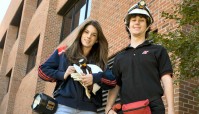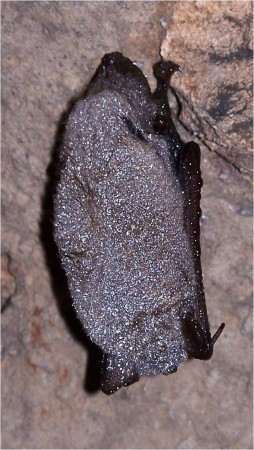
On Thursday, June 18th at 7 p.m Dr Andrew Barrass and students Seth McCormick and Morgan Kurz will present APSU’s study of the bats inside Dunbar Cave for the Friends of Dunbar Cave meeting. The meeting will be in the Visitor Center at the Dunbar Cave State Natural Area. This event is free, and open to the public. The presentation will include several segments of their research using a Power Point slide show, posters of cave surveys, photos of bats in the cave, and more.
For the last three years, the APSU’s Center of Excellence for Field Biology has been researching the bat population in Dunbar Cave. They call it the “Bat Project”. Dr. Andrew N. Barrass is the Project Manager, PI, with The Center of Excellence for Field Biology and an Associate Professor in the Biology Department.
We have been studying the bats in the cave since January of 2006. This was in response to a request by Park officials and State Biologists that recommended a survey of bats, both before and after the construction of the “Bat Friendly” steel gate, at the cave entrance in June 2006.

Dr. Barrass says that three kinds of bats use Dunbar Cave: Eastern Pipistrelles make up about 80-90% of the bats in Dunbar, Little Brown Bats make up about 5%, and Big Brown Bats make up less than 5%.
When we are lucky enough to see a bat in Dunbar Cave, generally it is an eastern pipistrelle bat. They hang by themselves and they are tiny—less than 2 inches long. When we have held Haunting History in Dunbar Cave around the end of October, we sometimes see a bat sleeping in a passage way. We are extra careful not to disturb it. If we wake a bat during its hibernation, it might die because there is no food available. Bats eat more mosquitoes than any other creature which is just one reason we want to keep bats around. They are also essential to the other life (what little there is) that exists in caves.
The Friends of Dunbar Cave and the Park staff are concerned about the noise that people make when they go into the cave and how it affects the bats. They hope the APSU study will be able to shed some light on that subject. Should they schedule Haunting History earlier in the year instead of at the end of October? Haunting History brings hundreds of people into the cave to see informational skits performed by actors from the Roxy Regional Theatre. It’s the major fundraiser for the Friends of Dunbar Cave who use the money to help the Park. However, neither the Friends group nor the Park staff wishes to endanger the bat population.
“The ‘Bat Project’ has many components such as a study of site fidelity by Pipistrelles–if they use the same roosting sites repeatedly; surveys of the population over time and seasonal variations; the affects of human noise on roosting bats; banding and marking bats for future studies; and most importantly the restoration of the bat population(s) in the Dunbar Cave State Natural Area.”
Dr. Barrass says they also plan to discuss current information about a crisis in the bat communities nationwide, called the White Nose Syndrome (WNS) that is linked to the deaths of greater than +400,000 bats within the last two years.

Dr. Barrass worked with Mr. Mike Wilson of the APSU Geographic Information Systems (GIS) to make maps of the cave and use those to plot out where the bats hang out. The Bat Project students enter the cave at least once a month and record data as to where they find the bats. Comparing that data over time and seasons they know that Pipistrelles use only certain chambers within the cave and avoid others. That is most likely due to human impacts-like the burned chamber, he says. Pipistrelles seem to like congregrating in groups and they hope to identify the location of a maternity roost (females gathering for care of their young).
Dr. Barrass says that he has been blessed to work with some wonderful students during the past few years. Sarah Jo Jenkins began the study in 2006. She was voted most outstanding Senior in the Biology Department. She recently graduated with an MS in Animal Science from UT-Knoxville and is now teaching as an Instructor in the Biology Department at APSU. Seth McCormick, an undergraduate, assisted Sarah Jo, and took full reins of the project in 2007. He has received two Presidential Research Scholarship awards in order to work on this project. In 2008, Seth was joined by Morgan Kurz, a graduate student. She was selected as a Graduate Assistant in the Biology Department and received a Graduate Research award this year. All of these students have presented scientific papers at the International meeting of the Animal Behavior Society during the last three years. Also, collectively, these students have presented, either by a poster-presentation or by oral presentations, over 19 scientific presentations pertaining to the research at Dunbar Cave State Natural Area. He believes this to be an outstanding accomplishment.
A Vanderbilt graduate, Andrew Barrass, holds a Ph.D. in Environmental Science and Environmental Engineering and is currently the Program Manager and former Director of The Center of Excellence for Field Biology and Associate Professor of the Biology Department at APSU. He served as Environmental Review Coordinator with the Division of Natural Heritage of the Tennessee Department of Environment and Conservation in 1994. He served on a Worldwide Technical Committee to review Effects of Noise on Breeding Bird Behavior with the Sea World Research Institute in San Diego in 1993. Among other accomplishments he was appointed as Manager of the State of Tennessee’s Nonpoint Source Water Pollution Program forTDEC in 1988. He served as Field Supervisor in the Houston Toad Recovery Project for the Zoological Society of Houston in 1984, and was on the Research Fellowship of Vanderbilt University (Environmental Science and Engineering)in 1983. He was appointed to the Research Fellowship at the University of Texas in Austin for the Marine Science Institute in 1982.


